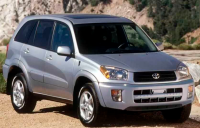Fuel system and exhaust system
• General information
• Technical characteristics of the fuel injection system
• Depressurising the fuel system
• General fuel system check
• Checking the fuel pump
• Checking the fuel pipes, hoses and connections
• Fuel pump
• Fuel pressure regulator
• Fuel level gauge
• Fuel tank
• Air filter casing
• Accelerator cable
• Electronic fuel injection system
• Checking the electronic fuel injection system
• Diagnosing the Toyota TCCS electronic fuel injection system with dynamic ignition
• Throttle unit
• Fuel pulsation damper on models from 2001
• Fuel distribution system and injectors
• Exhaust system
• Safety precautions for vehicles with catalytic converter
General information
The engine power system consists of fuel tank, electric fuel pump, fuel pressure regulator, EFI relay unit, fuel pump relay, fuel distribution line, injectors, air filter and throttle assembly and fuel lines. All models are equipped with a Sequential Electronic Fuel Injection system.
Sequential Electronic Fuel Injection system calculates the quantity and supplies fuel to the engine cylinders in the order they are operated. The injectors are controlled by the engine control module (PCM). Based on information from various sensors, the PCM unit controls the fuel injectors by changing the pulse length, i.e. the length of time the injectors are open. The amount of fuel varies constantly to provide the optimum ratio for hot or cold engine start, warm-up, idling and acceleration. The throttle only serves the purpose of controlling the amount of air supplied to the engine cylinders.
Fuel is fed from the fuel tank to the fuel system via metal tubes attached under the underside of the car. An electric fuel pump, fuel level sensor and pressure regulator are located in the fuel tank.
The fuel pump relay is controlled by two electrical circuits. The first circuit is controlled by the engine control module (PCM) and the second circuit is controlled by the ignition switch. If the engine does not start after the ignition is switched on, the PCM will deactivate the fuel pump relay after 2 seconds. The next time the engine starts, after the first pulse from the camshaft position sensor, the relay switches on the fuel pump.
The exhaust system consists of the exhaust manifold, tailpipe, centre and rear silencers and the catalytic converter. The catalytic converter cleans the exhaust gases.
Release of pressure in the fuel system
WARNINGS
Petrol is extremely flammable and the use of fire, sparking devices, open flammable lights and smoking is prohibited when working on parts of the fuel system. Avoid creating sparks when handling wires and electrical devices.
As petrol is carcinogenic, you must avoid getting it on your body or vehicle paintwork. If not, wash the affected area immediately with soap and water.
The fuel system is under continuous pressure so always depressurise the fuel system before disconnecting the lines.
Depressurise the fuel system as follows
- remove the plug from the fuel filler neck, which will equalise the pressure in the fuel tank with atmospheric pressure;
- to access the fuel pump/level sensor assembly, remove the rear seat and flap. Unplug the electrical connector from the fuel pump/level sensor assembly;
- start the engine and leave it running until it stops due to a lack of fuel in the fuel distribution line;
- switch off ignition and disconnect earth cable from battery.
The steps taken will depressurise the fuel system. Cover any fuel system connection with a clean rag and carefully unscrew the connection nut.
After carrying out work on the fuel system, connect
Checking the fuel pump
General check of the fuel pump. If insufficient capacity and reduced pressure generated by the fuel pump is suspected, proceed as follows:
- check the condition and state of charge of the battery and, if necessary, recharge it;
- check if the fuse in the fuel pump power supply circuit is in good condition;
- check the condition of the fuel pipes and hoses for leaks;
Check the operation of the fuel pump by ear. An assistant should turn the ignition key to the "ignition on" position and you should hear a click and noise from the pump for 2 seconds (fuel pump noise is best heard through the fuel tank filler neck). If the fuel pump does not work, check the electrical supply circuit to the fuel pump. If the fuel pump operates but does not produce the required pressure, check the pressure generated by the pump.
Check the pressure generated by the fuel pump. To check the pressure in the fuel system, have a pressure gauge and an appropriate adapter for connection to the fuel system with the following remarks
- on pre-2001 models, the fuel hoses are connected with hollow bolts with washers to the fuel filter, the fuel filter is mounted on the bracket on the left side in the engine compartment;
- on models from 2001 the fuel hoses are connected with quick-release connectors and the fuel filter is mounted on the fuel pump assembly.
Depressurise the fuel system.
Connect a pressure gauge to measure the pressure as follows:
Checking the fuel pipes, hoses and connections
Check the fuel pipes, hoses and their connections as follows.
Depressurise the fuel system.
The metal fuel pipes are fastened with clips and self-tapping screws under the car's underside. Inspect them periodically for leaks and damage.
If there is dirt in the fuel filter and the fuel pipes when replacing the filter, be sure to disconnect the pipes and blow them out with compressed air. Also check the condition of the strainer on the fuel pump assembly.
Never use copper or aluminium tubes as a substitute for the steel tubes fitted to the car as they may not survive the vibration of the car's operation.
As the fuel pipes are under high pressure they require special maintenance.
Some fuel lines have threaded joints with o-rings that must be loosened before service or replacement of components. These connections use cone nuts which, when the nut is tightened, additionally crimp the connection. Check the sealing rings for cracks and damage and replace if necessary. If steel pipes are replaced, only fit original pipes.
Keep flexible fuel hoses at least 100 mm away from the exhaust system components and 250 mm from the catalytic converter.
On certain models, nylon fuel hoses with quick-release connectors are fitted. In this case, when a single hose must be replaced, replace the hoses with a set of quick-release connectors.
Replace fuel pipes/hoses as follows.
Depressurise the fuel system.
Detach all clips securing the pipe/hose to the car body.
On the normal connections of the steel fuel pipe and hose, loosen the clamp, then pull out the tube/hose. Turning the tube and hose in different directions makes it easier to disconnect.
Fuel pump
To remove the fuel pump, proceed as follows.
Depressurise the fuel system.
Remove the filler cap from the fuel tank filler neck.
Switch off the ignition and disconnect the earth lead from the battery.
Exhaust system
Safety measures when using vehicles with catalytic converter
Only inspect and repair components of the exhaust system when they have cooled down completely.
The exhaust system allows the exhaust gases to be vented to the atmosphere, reducing the concentration of pollutants and reducing engine noise to the required level with minimal loss of engine power. In order for the exhaust system to fulfil its purpose, it must be in good working order. The condition of the exhaust system also has an impact on the engine's power output and fuel consumption.
The exhaust system consists of the exhaust manifold, the exhaust pipe, catalytic converter and silencers.
The exhaust pipes serve to connect the different components of the exhaust system together.
The purpose of the silencers is to smooth out any pulsations in the exhaust gas flow and reduce noise. Silencers rely on two physical effects - resonance and sound absorption. Mufflers normally use a combination of these effects.
Resonance silencers consist of chambers of different lengths connected by pipes. The difference in the cross-sectional areas of the tubes and chambers, the reversal of the exhaust gas flow and the presence of resonators together with the connecting tubes and chambers ensure optimal noise reduction, particularly at low frequencies.
The exhaust system is secured to the underbody of the car using elastic elements, in order to reduce vibrations from the passage of the exhaust gases.
When the engine is cold, check the condition of the exhaust system along its entire length.
Check the pipes and connections for leaks, corrosion and damage. If components of the exhaust system are corroded, disconnect them from the exhaust system and replace them with new ones. If the exhaust system pipes are difficult to disconnect, use an autogenous welder to heat the pipe joints and disconnect them.
Check that all the brackets and suspension elements of the exhaust system are in good condition and evenly tensioned.
Moving the exhaust system sideways, check that it is not touching the car's bodywork. If it does not, replace the rubber surrounds on the exhaust system.
When repairing the exhaust system, be sure to observe the following
- when removing exhaust system components, start at the rear;
- to make it easier to loosen the nuts and bolts of the exhaust system connections, first soak the nuts and bolts with joint loosening fluid;
- when reassembling, use new gaskets, rubber hangers and clamps for the exhaust system mountings;
- before reinstalling the system components, clean their joints with emery cloth to remove sealing compound and rust residue;
- to facilitate subsequent unscrewing, apply high temperature paste to the nuts and bolts securing the exhaust system.
After working on the exhaust system, check that the system is mounted freely, without stress and that there is sufficient clearance from the bodywork.
Safety precautions for vehicles with catalytic converter
The neutraliser is a reliable and simple device that requires no maintenance. In order to maximise its service life, the following requirements must be observed.
Do not use leaded gasoline in a vehicle equipped with a catalytic converter as lead will coat the precious metals in the catalytic converter grid, reducing its effectiveness and resulting in catalytic converter failure.
Always keep the ignition and power system in good working order.
Do not operate the vehicle with a defective ignition system until the fault has been rectified.
If the engine control light illuminates when the engine is running, have the vehicle serviced by a workshop as soon as possible. If the engine management system is defective, in addition to increased fuel consumption and impaired engine performance, the catalytic converter could be damaged.
Do not start the engine by towing.
Do not switch off ignition at high engine speeds.
Do not use fuel or engine oil additives as they may contain substances that can damage the catalytic converter.
Do not use the vehicle if blue smoke is emitted from the exhaust pipe.
After stopping the engine, the exhaust system continues to emit heat for an extended period of time, so avoid parking the car on grass and dry leaves.
Bear in mind that the neutraliser is fragile, so avoid impacts when removing it or other parts of the exhaust system.




